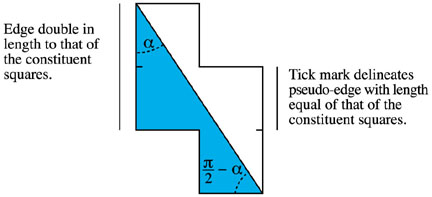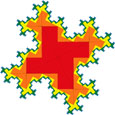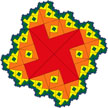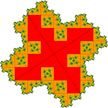Fractal Tilings with Prototiles that can be Generated by Dissecting Polyominoes
Most polyominoes have straight-line segments longer than one square edge.

As a result, there are relatively few true edge-to-edge f-tilings.
To allow a greater variety, pseudo-edge-to-edge f-tilings will be considered as well.
Each prototile has one or two long edges and two or more short edges. The angles between these are in general irrational and sum to a multiple of π/2.
The following table shows the lower-order polyominoes (blue) that possess 2- or 4-fold rotational symmetry, along with candidate prototiles derived by dissecting them. The red prototiles admit one or more pseudo-edge-to-edge f-tilings, the green prototiles admit one or more true edge-to-edge f-tilings, and the black prototiles do not admit f-tilings.
Click on the red or green prototiles below to see the fractal tiling(s) based on the prototile.
After the table, there are links to f-tilings based on higher-order polyominoes.
Monomino (square):







Domino:






Tromino:







1st tetromino:







2nd tetromino:









3rd tetromino:







1st pentomino:









2nd pentomino:











3rd pentomino:









Some f-tilings generated from higher-order polyominoes follow.
A hexomino f-tiling:


Two octomino f-tilings using the same prototile:




Two 16-omino f-tilings using the same prototile:


Go to Fractal Tiling Compendium Home
Webmaster: Robert Fathauer; rob@tessellations.com

















































































